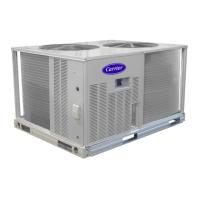10
.INSTALLATION
Jobsite Survey
Complete the following checks before installation.
1. Consult local building codes or the U.S.A. National
Electrical Code (Ref: ANSI /N F PA 70, [American Na-
tional Stan dar ds Institute/N atio nal Fir e Pro tection As-
sociatio n ], lates t rev is io n) for sp ecial installation re-
quirements
2. Determi ne unit location (from project plans) or select
unit location.
3. Check for possible overhead obstructions which may
interfere with unit lifting or rigging.
Step 1 — Plan for Unit Location
Select a location for the unit and its support system (pad,
rails or other) that provides for the minimum clearances
required for safety. This includes the clearance to
combu s tible surf aces , unit perform ance and service access
below, around and above unit as specified in unit drawings.
See Fig.4.
NOTE: Local codes may require different clearances
than specified in Fig. 4. It is the responsibility of installers
to be knowledgeable in local codes and to modify the
recommended clearances to satisfy local codes.
NOTE: Consider also the effect of adjacent units on
airflow performance and control box safety clearance.
REAR:
Min 18” (457 mm)
requried for service
Note: Observe requirements for 39” (914 mm) operating clearance
on either Left or Rear coil opening.
RIGHT:
Min 18” (457 mm)
requried for service
LEFT:
Min 18” (457 mm)
requried for service
FRONT:
42” (1067 mm)
C110201
Fig. 4 -- Service Clearance Dimensional Drawing
Do not install the outdoor unit in an area where fresh air
supply to the outdoor coil may be restrict ed or when
recirculation from the condenser fan discharge is possible.
Do not locate the unit in a well or next to high walls.
Evaluate the path and required line length for
intercon n ecting refrigeratio n piping, includin g suction riser
requirements (outdoor unit above indoor unit), liquid line lift
(outdoor unit below indoor unit) and hot gas bypass line.
Relocate sections to minimize the length of interconnecting
tubing.
DO NOT BURY REFRIGERATION LINES.
Although unit is weatherproof, avoid locations that permit
water from higher leve l runoff and overhangs to fall onto
the unit.
Step 2 — Complete Pre-Installation Checks
Ch eck Un it Electrical Cha ract eris tics: Confirm before
installatio n of unit that voltage, amperage and circuit
protectio n requir ements listed on unit data plate agree with
power supply provided.
Un--crate Unit: Remove unit packaging except for the top
skid assembly, which should be left in place until after the
unit is rigged into its final locat ion.
Inspect Shipment: File a claim with shipping company if
the shipment is damaged or incomplete.
Consider System Requirements:
S Consult local building codes or the U.S.A. National
Electrical Code (R ef: ANS I /N F PA 70, [American
Nation al Standard s Institute/N atio nal Fire Protection
As s o ciation ], latest rev is ion ) for special installation
requirements.
S Allow sufficient space for airflow clearance, wiring,
refrigerant piping, and servicing unit. See Fig. 1 for unit
dimensions and weight distribution data.
S Locate the unit so that t he outdoor coil (condenser)
airflow is unrestricted on all sides and above.
S The unit may be mounted on a level pa d directly on the
base c hannels or mounted on raised pads at support
points. See Tables 1A through 2B for unit operating
weights. See Fig. 1 for weight distribution based on
recom mended support points.
NOTE: If vibration isolators are required for a particular
installation, use the data in Fig. 1 to make the proper
selection.
Step 3 — Prepare Unit Mounting Support
Slab Mount —
Provide a level concrete slab that extends a minimum of
150 mm (6 in.) beyond unit cabinet. Install a gravel apron
in front of condenser coil air inlet to prevent grass and
foliage from obstructing airflow.
Step 4 — Rig and Mount the Unit
UNIT DAMAGE HAZARD
Failure to follow this caution may result in equipment
dama ge.
All pane ls must be in place when rigging. Unit is not
designed for handling by fork truck.
CAUTION
!
Rigging: These units are designed for overhead rigging.
Refer to the rigging label for preferred rigging method.
Spreader bars are not required if top crating is left on the
unit. All panels must be in place when rigging. As further
protection for coil faces, plywood sheets may be placed
agai nst the sides of the unit, behind cables. Run cables to
a central suspension point so that the angle from the
38AU

